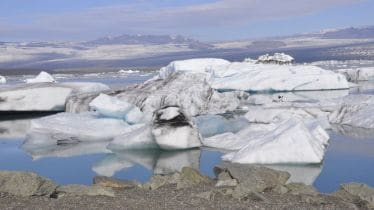Even as the world has moved on from the horrors of the coronavirus pandemic, humanity is staring at a possible epidemic that may put a fullstop on the much needed covid recovery around the globe. Researchers have been busy studying the zombie viruses in Russia. There are possible pathogens that can survive the permafrost posing threat to humans who cannot be immune to these viruses nor have drugs to treat them.
Jean-Michel Claverie holds the title of emeritus professor at Aix-Marseille University’s School of Medicine. His discoveries bring to light the grim reality of global warming as it thaws ground which has been frozen since thousands of years. Jean-Michel, 73, has spent more than ten years studying “giant” viruses which includes ones that are nearly 50,000 years old and were found deep within layers of Siberian permafrost.
Scientists have been predicting the possibility of the Arctic being ice-free by the summers of 2030s since the planet is already 1.2C warmer than the pre-industrial times. There have been concerns related to the release of greenhouse gases into the atmosphere that are trapped like methane. The danger of dormant pathogens are explored less.
A research was published last year by Claverie’s team which mentioned that they’d extracted multiple ancient viruses from the Siberian permafrost and all of them remained infectious.
In an interview at his laboratory located on the Luminy campus of Aix-Marseille University in France, Claverie pointed out, ‘Traditionally, we associate climate change dangers with threats originating from the south, such as the spread of vector-borne diseases from warmer tropical regions. However, it has become increasingly apparent that there could be emerging risks from the north due to the thawing of permafrost, releasing microbes, bacteria, and viruses.’
The threatening ways of this are still emerging. Anthrax spores were activated by a heat wave in Siberia in the summer of 2016 which led to dozens of infections. Thousands of reindeer and a child died in the spread of infection.
A separate team of scientists published their findings in July this year. The findings showed that even multicellular organisms could survive permafrost conditions in an inactive metabolic state which is called cryptobiosis. The scientists successfully reanimated a 46,000-year-old roundworm from the Siberian permafrost, just by re-hydrating it.
“It holds great significance in the sense that we have the capability to halt life and subsequently initiate it once more,” states Teymuras Kurzchalia, a professor emeritus at the Max Planck Institute of Molecular Cell Biology and Genetics, who played a role in the research. This suggests that certain living organisms possess an inherent ability to reduce or temporarily pause their metabolic functions.
Global health agencies and governments have been monitoring for unknown infectious diseases for several years. These are diseases which humans would neither have immunity against nor drug therapies. In 2017 the World Health Organization added a generic “Disease X” to a shortlist of pathogens which are considered a top priority for research. WHO aims to develop a roadmap to prevent or contain an epidemic that can be caused by these pathogens. The efforts have intensified after the world was shut down by the deadly Covid-19 virus.
What Is Disease X? On the Lookout for Next Pandemic: QuickTake
While not directly related, Claverie’s research shares a common frontier. Nestled in the outskirts of Marseille, France, his laboratory appears like a curiosity shop or the abode of an eccentric collector. Soil samples in plastic bottles and unassuming brown liquids in glass vials vie for shelf space, while his office displays a woolly rhino vertebra and remnants of a mammoth tusk found during a 2019 Siberian expedition. However, the presence of expensive equipment and a biosafety room indicates the seriousness of his work.
With a background in theoretical particle physics, applied computer science, and biochemistry, Claverie lacked formal training in immunology, which he believes offered him a fresh perspective. His journey into theoretical biology began in 1979 when he turned down an offer to work with renowned MIT biophysicist Alexander Rich to seek out Francis Crick, the Nobel-winning biologist who unraveled DNA’s molecular structure. This chance encounter led to a job referral from Crick himself.
Claverie’s fascination with permafrost, layers of frozen earth enduring temperatures below freezing for at least two years, was kindled by the revival of a flowering plant frozen for 30,000 years. This prompted him to explore the potential resurrection of viruses from ancient permafrost. In 2014, he demonstrated the revival of “live” viruses from Siberian permafrost, focusing on viruses infecting amoebas to prevent accidental human contamination. In 2019, his team isolated 13 new viruses, one of which had been frozen for over 48,500 years, from various ancient Siberian permafrost samples, underscoring their widespread presence.
Claverie highlighted the potentially “disastrous” consequences of an unknown ancient pathogen resurfacing in humans, citing the extinction of Neanderthals as an example. Permafrost’s unique conditions, lacking oxygen and chemical activity, make it ideal for preserving organic matter. Siberia, home to permafrost layers up to a kilometer deep, harbors thousands of dormant microbe species in just one gram of soil.
However, the stability of permafrost layers, intact for 400,000 years, is now threatened as the Arctic warms at an alarming rate. Methane craters and sinking towns are emerging across the region. Geopolitical tensions have further complicated research, hindering collaboration with Russian labs and colleagues.
While global warming poses risks to Russian infrastructure and contributes to environmental disasters, the region holds vast natural resources. Russia’s active mining of permafrost raises concerns about human interaction with ancient pathogens. The dilemma lies in inadvertently propagating danger while researching potential threats.
Some advocate less resource-intensive approaches, like monitoring the Inuit population for diseases linked to permafrost. Larger organizations are also reconsidering their virus-hunting projects due to concerns about sparking pandemics.
Claverie, regardless of the war’s outcome, has decided not to return to Siberia. He believes he has conveyed the existence of the danger and that further expeditions into the frozen depths would be unwise.
